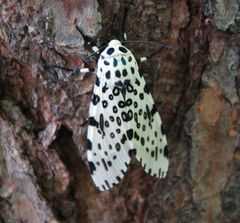Giant leopard moth
| Giant Leopard Moth | |
|---|---|
 | |
| Conservation status | |
| Scientific classification | |
| Kingdom: | Animalia |
| Phylum: | Arthropoda |
| Class: | Insecta |
| Order: | Lepidoptera |
| Family: | Arctiidae |
| Tribe: | Arctiini |
| Genus: | Hypercompe |
| Species: | H. scribonia |
| Binomial name | |
| Hypercompe scribonia (Stoll, 1790) | |
| Subspecies | |
| |
| Synonyms | |
| |
The Giant Leopard Moth or Eyed Tiger Moth (Hypercompe scribonia) is a moth of the family Arctiidae. It is distributed throughout southern Ontario, and southern and eastern United States from New England to Mexico. [2] The obsolete name Ecpantheria scribonia is still occasionally encountered.
This species has a wingspan of 76 mm (3 in). The wings of this moth are bright white with a pattern of neat black blotches, some solid and some hollow. The abdomen is dark blue with orange markings, the male has a narrow yellow line on the sides. Its legs have black and white bands. Adult moths are strictly nocturnal and do not generally fly before nightfall.[3]
The caterpillar is of the "Woolly Bear" kind, with a thick coat of black bristles (setae) and red or orange colored bands between its segments, which become conspicuous when the caterpillar rolls into a ball for defense.
Recorded food plants
The caterpillar eats a variety of broad-leaf plants such as broadleaf plantains, dandelions and violets:
|
Gallery
-

Larval stage
-

Caterpillar in typical defensive ball
-

Caterpillar with typical red stripes
-

head of a caterpillar
-

Closeup of head and thorax
-

Closeup showing iridescent blue spots
-

Closeup of newly eclosed moth
-

Showing the old skin, empty pupal shell, and adult moth
-

Last image at night before it flew off once wings dried
-

Wings spread, displaying abdomen colors
-

Close-up while wings upswept
-

The moment before take-off
References
- ↑ Poole, Robert W.; Patricia Gentili (1996). "Hypercompe scribonia". NatureServe. Retrieved 18 July 2013.
- ↑ Hypercompe scribonia, Butterflies and moths of North America
- ↑ Fullard, James H. & Napoleone, Nadia (2001). Diel flight periodicity and the evolution of auditory defences in the Macrolepidoptera. Animal Behaviour 62(2): 349–368. doi:10.1006/anbe.2001.1753 PDF fulltext
External links
| Wikimedia Commons has media related to Giant Leopard Moth. |
